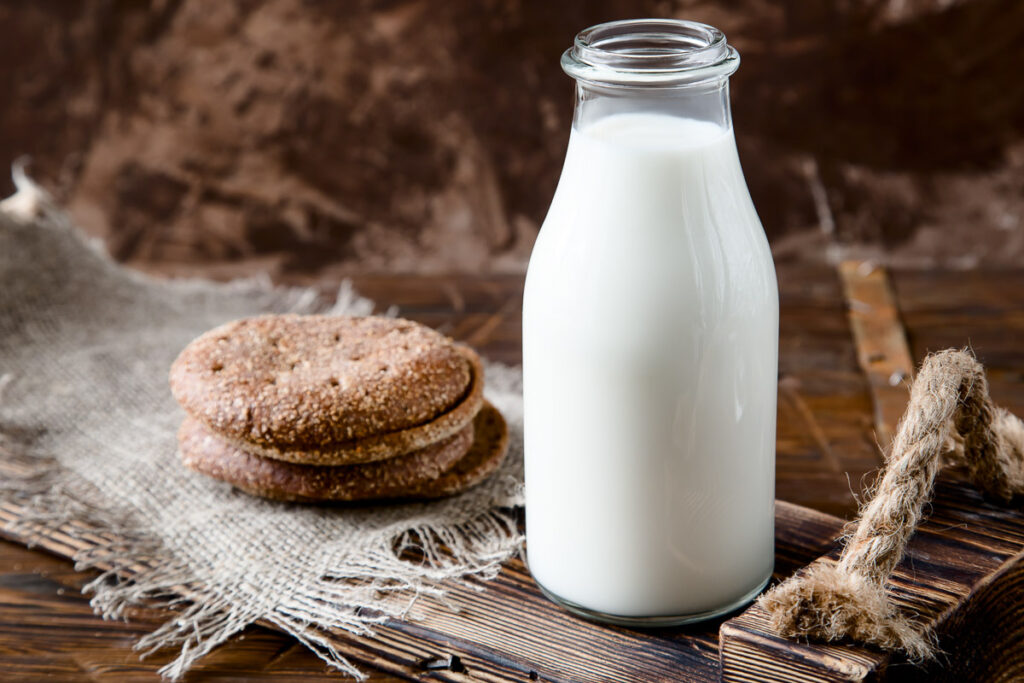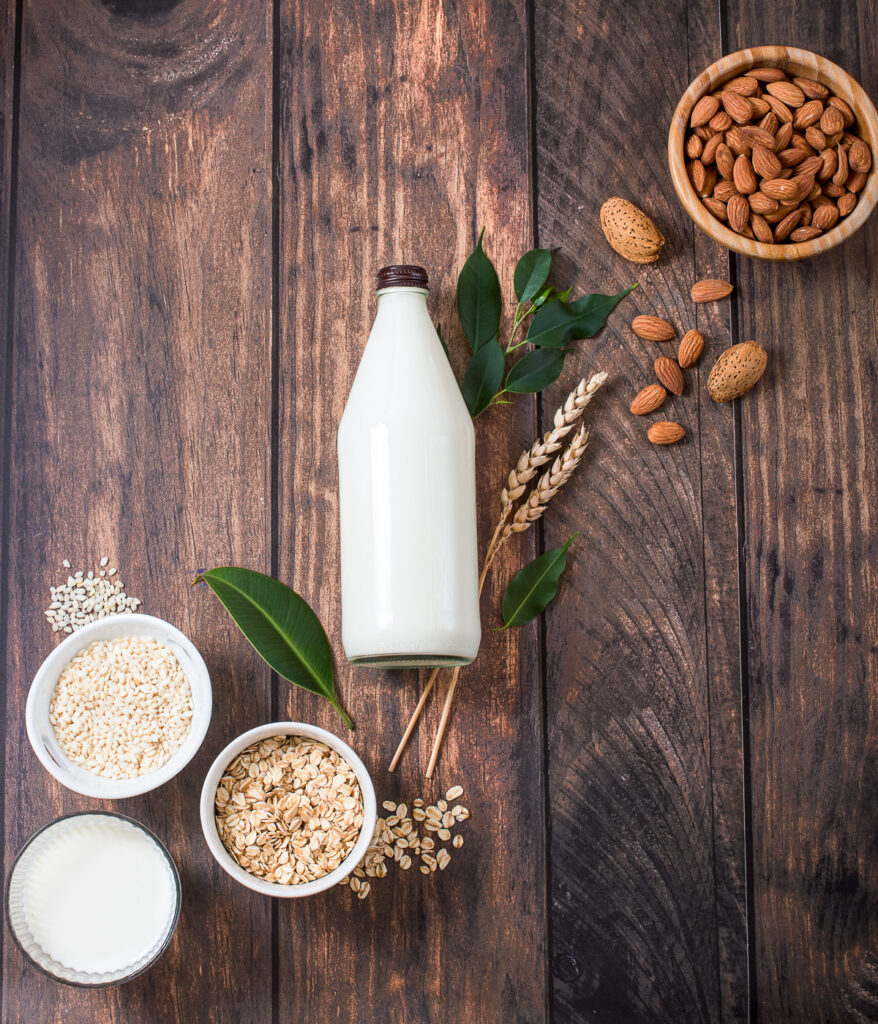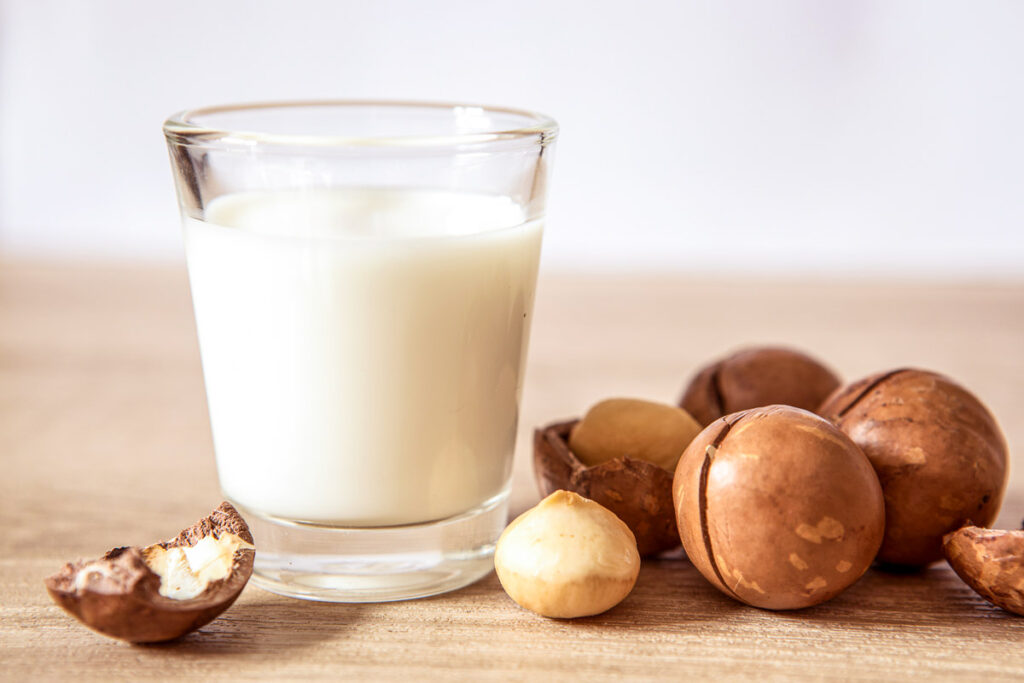Types of Milk for Cooking and Baking: A Creamy Guide to Culinary Excellence
Milk, in its myriad forms, is not just a staple in our fridges but a chameleon in the kitchen. From creamy sauces to fluffy cakes, it’s a foundational ingredient that can transform a recipe. Today, we’re diving deep into the world of milk, exploring its diverse types and their unique roles in cooking and baking. We’ll also tackle the art of substituting these kinds of milk in recipes, ensuring you’re never caught off-guard when the carton runs dry.

Animal’s milk – heaviest to lightest
Heavy cream: luxurious and rich
Heavy cream, known for its high-fat content (typically around 36-40%), is a staple in luxurious sauces, decadent desserts, and whipped toppings. It’s the ultimate ingredient for richness and texture.
Heavy cream in baking
In baking, heavy cream creates a rich, tender crumb in cakes and pastries. It can also be whipped into frostings or used as a filling. For recipes that call for milk, using heavy cream significantly enhances the richness, making it ideal for indulgent desserts.
Sweetened condensed milk: the dessert game-changer
Sweetened condensed milk is a concentrated, sugar-laden version of milk, known for its thick, syrupy texture and caramel-like sweetness. It’s a staple in many dessert recipes, from fudgy brownies to creamy pies.
Sweetened condensed milk is a dessert game-changer. This thick, sweet concoction removes water from milk and adds sugar, resulting in a rich, creamy texture.
Using condensed milk as a creative substitute
Sweetened condensed milk can be a creative substitute in recipes that call for milk and sugar. It adds not only sweetness but also a dense, creamy texture. It’s particularly great in dessert recipes where a rich, moist outcome is desired, like in tres leches cake or sweet bread puddings.
Evaporated milk: the intense flavor booster
Evaporated milk is whole milk with about 60% of its water content removed. It’s less sweet than condensed milk, offering a concentrated milk flavor ideal for sweet and savory dishes.
Using evaporated milk in baking
Evaporated milk can be a fantastic substitute in baking, particularly in recipes where a denser, creamier texture is desired. It’s ideal for use in custards, pies, and creamy desserts. When substituting, it’s often diluted with an equal amount of water to mimic the consistency of regular milk.
Half and half: the perfect middle
Half and half, a blend of equal parts whole milk and cream, strikes a delightful balance between lightness and creaminess. It’s a popular choice in coffee, but its culinary uses extend far beyond.
Half and half in baking and cooking
In recipes, half and half can often substitute for milk or cream, depending on the desired richness. It’s great in quiches, creamy sauces, and soups. In baking, it can replace milk to add a bit more body and richness to the final product, such as in scones and cakes.

Whole milk: the rich and versatile classic
Whole milk, the epitome of milk’s natural state, is revered for its rich, creamy texture and balanced flavor. With about 3.5% fat content, it’s the gold standard in many traditional recipes, from creamy béchamel to moist cakes. It’s the all-rounder of the milk world, lending moisture and richness to baked goods and adding depth to savory dishes.
Mastering substitutions with whole milk
Have you run out of whole milk? Combining 1 cup of 2% milk with a tablespoon of heavy cream can mimic whole milk’s luxurious texture. This mix can seamlessly slip into recipes, balancing richness and fluidity.
Goat milk: the distinct alternative
With its unique flavor profile, goat milk is a less common but intriguing option. It’s slightly sweeter and more robust than cow’s milk and is easier for some people to digest.
Goat milk in culinary applications
In cooking and baking, goat milk can replace cow’s milk for a distinct flavor twist. It’s particularly popular in artisan cheeses, but it can also bring a new dimension to baked goods and creamy sauces.
Buttermilk: the tangy baker’s delight
Buttermilk, traditionally the liquid left after churning butter, is now often referred to as cultured buttermilk. It’s known for its tangy flavor and slightly thicker consistency.
Buttermilk in baking
Buttermilk is a staple in baking due to its acidic content. It helps tenderize gluten, giving baked goods a softer texture and more body. It’s often used in recipes for pancakes, biscuits, and cakes. When regular milk is called for, buttermilk can be substituted by adding a bit of lemon juice or vinegar to mimic its acidity.
Kefir: the probiotic-rich choice
Kefir is a fermented milk drink similar to a thin yogurt, known for its probiotic content and tangy flavor.
Kefir in culinary uses
Kefir can be used in smoothies, salad dressings, and marinating meats. It can replace buttermilk or yogurt, adding a slight tanginess and contributing to the leavening process in baked goods like sourdough bread and muffins.
A2 milk: the gentle alternative
A2 milk is produced from cows that naturally produce only the A2 type of beta-casein protein, which some people find easier to digest than the A1 protein commonly found in regular cow’s milk.
A2 milk in the kitchen
Regarding cooking and baking, A2 milk behaves just like regular cow’s milk, making it a suitable choice for any recipe. It’s particularly useful for those who experience discomfort with standard dairy products.
2% milk: a lighter, yet flavorful alternative
2% milk, a less fatty sibling of whole milk, offers a lighter option without compromising too much on taste and texture. It’s a fantastic choice for everyday cooking and baking, providing a decent amount of richness without the heft of whole milk.
The art of baking with 2% milk
Baking with 2% milk is a breeze. Its slightly reduced fat content is often unnoticeable in most recipes. It can replace whole milk cup for cup in cakes, cookies, and even bread, ensuring a tender crumb and moist texture. This subtle compromise can be a boon for lighter, airier baked goods.

Powdered milk: the convenient staple
Powdered milk, or dry milk, is made by evaporating milk to dryness. It’s valued for its long shelf life and portability.
Powdered milk in cooking and baking
In cooking and baking, powdered milk can be reconstituted with water and used as a substitute for fresh milk. It’s particularly useful in bread-making and can be added directly to dry ingredients in baking recipes. Powdered milk is also used in confectionery items like chocolate and caramel for a smooth, creamy texture.
Lactose-free milk: the digestion-friendly option
Lactose-free milk is cow’s milk that has been treated to break down lactose, making it easier to digest while retaining the same flavor and nutritional profile as regular milk.
Lactose-Free Milk in Culinary Applications
Lactose-free milk can be used in any recipe that calls for regular milk, making it an excellent option for those with lactose intolerance. Its versatility extends to all forms of cooking and baking, from making smooth, creamy sauces to moist and tender baked goods.
Skim milk: the feather-light option
Skim milk, devoid of fat, is the marathon runner of the dairy section – lean and efficient. It’s ideal for those seeking to reduce their fat intake without giving up on milk altogether.
Navigating baking with skim milk
In baking, substituting skim milk for whole milk is a game of expectations. It can certainly do the job, especially in recipes where milk’s role is more about hydration than richness. However, it may result in baked goods that are slightly less moist and tender.
Plant-based milk

Almond milk: a nutty, dairy-free favorite
Almond milk has emerged as a popular dairy-free alternative. Its subtle nutty flavor and surprisingly creamy texture make it an excellent choice for those following a plant-based diet or with lactose intolerance.
Baking with the almond twist
When baking almond milk, choose unsweetened varieties to control the overall sweetness of the dish. It’s great for muffins, pancakes, and even savory bread, offering a distinctive flavor profile that can enhance the final product.
In our household, we use almond milk exclusively when we bake, as one of us is lactose intolerant.
Soy milk: the plant-based heavyweight
Soy milk, with its rich and creamy texture, is a plant-based milk that closely mimics the properties of cow’s milk. It’s nutrient-rich and offers a slightly sweet, bean-like flavor.
The baking dynamics of soy milk
In baking, soy milk shines as a substitute for whole milk. Its similar protein and fat content ensures that cakes rise beautifully, and cookies retain that desirable chewiness. It’s particularly effective in recipes where the milk’s role is both structural and flavorful.
Oat milk: the creamy plant-based option
Oat milk, one of the newer additions to the plant-based milk scene, is known for its creamy texture and mild, slightly sweet flavor. It’s become a favorite for both drinking and cooking.
Baking and cooking with oat milk
Oat milk can replace cow’s milk in most baking and cooking applications, offering a richness similar to whole milk. It works particularly well in moist cakes, creamy soups, and sauces, where its texture can shine.
Rice milk: the lightest plant milk
Rice milk is the most watery of the plant-based milk options, with a subtly sweet flavor. It’s a great choice for those with nuts, soy, or dairy allergies.
Using rice milk in the kitchen
Due to its thin consistency, rice milk is best used in recipes where a lighter texture is desired. It can be used in baking, but expect the end product to be less rich and creamy than other milk types.

Coconut milk: the tropical treasure
Coconut milk, derived from the flesh of mature coconuts, is a rich, creamy, and subtly sweet liquid. It’s a staple in tropical cuisines and is known for its distinct flavor.
Coconut milk in cooking and baking
Coconut milk is incredibly versatile, perfect for imparting a creamy texture and exotic flavor to dishes. It’s a key ingredient in curries, soups, and stews. In baking, it can replace dairy milk and cream, especially in recipes where its unique flavor complements the other ingredients, like in coconut cakes or tropical-flavored desserts.
Cashew milk: the creamy nut alternative
Cashew milk, made from blended cashews and water, is another plant-based option. It’s creamy and has a milder taste than almond milk, making it a great dairy substitute.
Cashew milk in culinary uses
In the kitchen, cashew milk is a fantastic dairy replacement, particularly in creamy sauces and soups. In baking, it provides moisture without an overpowering flavor, making it suitable for a wide range of recipes.
Hemp milk: the nutty, earthy option
Hemp milk, produced from the hemp plant seeds, has a nutty, earthy flavor. It’s rich in plant-based proteins and omega-3 fatty acids, making it a nutritious dairy alternative.
Hemp milk in cooking and baking
Hemp milk can be used in cooking and baking as a direct substitute for cow’s milk. Its distinct taste is best suited for recipes whose nutty flavor can be an asset, like whole-grain bread or health-focused baked goods.
Macadamia milk: the luxuriously smooth choice
Macadamia milk, with its rich buttery flavor, is a relatively new entrant to the plant-based milk scene. It’s known for its smooth texture and luxurious taste.

Using macadamia milk in the kitchen
This milk is ideal for adding a touch of elegance to coffee and smoothies. In cooking and baking, it can replace dairy milk, lending a rich, buttery flavor to desserts and baked goods.
Pea milk: the protein-packed alternative
Pea milk, made from yellow peas, stands out for its high protein content and sustainability. It has a creamy texture and a neutral flavor, making it a versatile dairy substitute.
Incorporating pea milk into recipes
Pea milk is an excellent substitute for cow’s milk in cooking and baking, especially in recipes that benefit from its protein content, like smoothies, creamy soups, and protein-rich baked goods.
Flax milk: the light and nutritious option
Flax milk, derived from cold-pressed flax oil mixed with water, is a light, dairy-free alternative. It’s high in omega-3 fatty acids and has a mild, slightly nutty flavor.
Flax milk in cooking and baking
This milk is great for everyday use, from cereals to smoothies. It can replace regular milk in baking, offering a lighter texture and subtle nuttiness to cakes, muffins, and bread.
The diversity of milk available today offers a wealth of options for cooking and baking, catering to a wide range of dietary preferences and culinary needs. From the tropical richness of coconut milk to the subtle nuttiness of flax milk, each type brings its unique qualities to the table. Understanding these differences allows for creative adaptations in the kitchen, ensuring that every recipe can be tailored to taste and dietary requirements.
Photo credit from Deposit Photos and the contributors.
Transitioning from the theatrical stage with her BA in theater to the culinary world, Elaine Benoit exemplifies how passion can reshape a career. As the CEO of Dishes Delish, she skillfully combines health-conscious and soul-satisfying recipes with expertly mixed cocktails. Elaine also explores the world of food through her podcast "Dishing," sharing her gastronomic journeys. Further, as a co-owner of Food Blogger Help, she dedicates herself to mentoring emerging food bloggers, offering them the tools for success. Elaine's multifaceted background, from acting to culinary arts, positions her as a guiding light in the digital food sphere.
